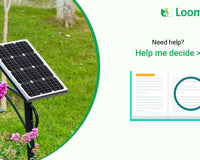An inverter with a battery backup can be a valuable device for an average household, especially in places where power cuts are frequent or unpredictable.
Here are some of the advantages of an inverter with a battery backup are:
- It can provide reliable and uninterrupted power to your essential appliances, such as lights, fans, TV, fridge, etc. during power deficiency.
- It is rechargeable from the grid or solar panels when the power is available and stores the electricity in the battery for later use.
- Saving your electricity bills by using the stored electricity during peak hours or when the grid tariffs are high.
- It can work with great efficiency and is highly reliable, as it does not produce any harmful emissions or noise.
To choose the right inverter and battery for your home, you need to consider your power requirement, the VA rating of the inverter, the battery capacity, and the type and quality of the battery. You can consider Loom Solar for the best results.
Off-Grid Solar Inverters
These are inverters that work independently of the grid and store the excess solar power in batteries for backup. They range from 500W to 10kW power ratings and have different features such as MPPT technology, LCD display, overload protection, etc.
On-Grid Solar Inverters
These are inverters that work in sync with the grid and feed the excess solar power to the grid for credits or sell it to a third party. They range from 1kW to 100kW power ratings and have different features such as single-phase or three-phase output, multiple MPPTs, Wi-Fi monitoring, etc.
Battery specifications
They have different types of batteries for different purposes, such as lithium batteries, lead-acid batteries, and sealed maintenance-free batteries.
Some of the specifications of their batteries are:
Capacity: They have batteries ranging from 6 Ah to 200 Ah in capacity. The higher the capacity, the more energy the battery can store and supply.
Voltage: They have batteries with 12V, 12.8V, and 48V voltage ratings. The voltage determines how much power the battery can deliver at a given current.
Technology: They have batteries with MPPT and poly panels technology. MPPT stands for maximum power point tracking, which is a technique to optimize the output of solar panels. Poly panels are made of polycrystalline silicon, which is cheaper but less efficient than monocrystalline silicon.
Warranty: They offer 2 years warranty for their CAML lithium batteries and 5 years warranty for their 100 Ah / 48 Volt lithium battery. The warranty covers any defects or malfunctions in the battery during the specified period.
To get a more accurate assessment, it's advisable to consult with a solar energy system installer or an expert who can design a solution tailored to your individual needs.












